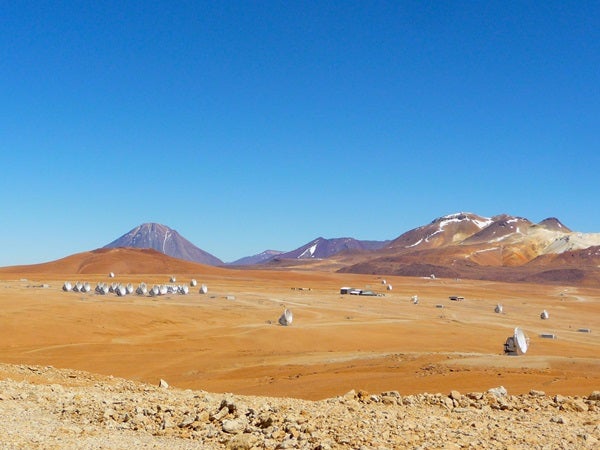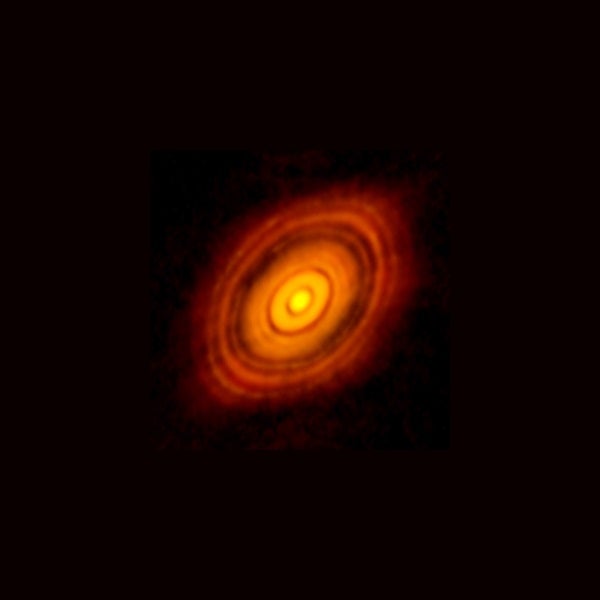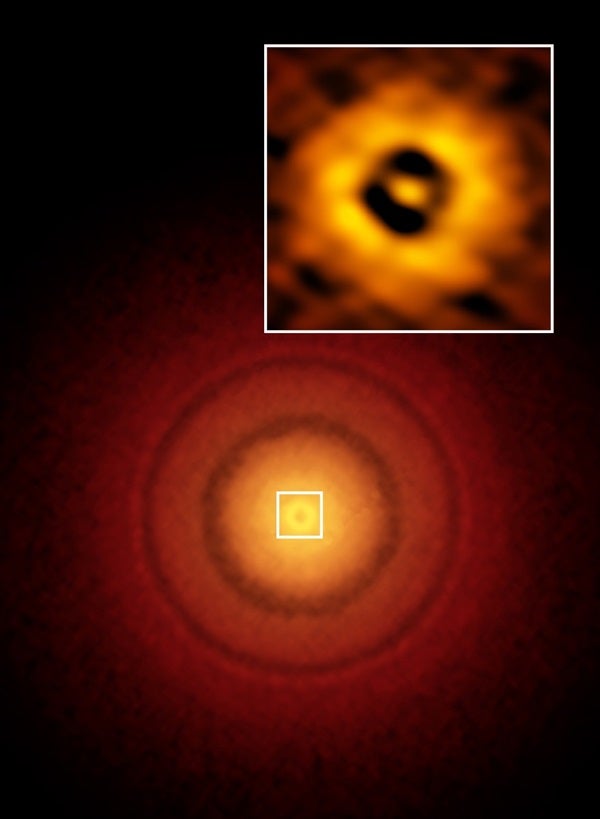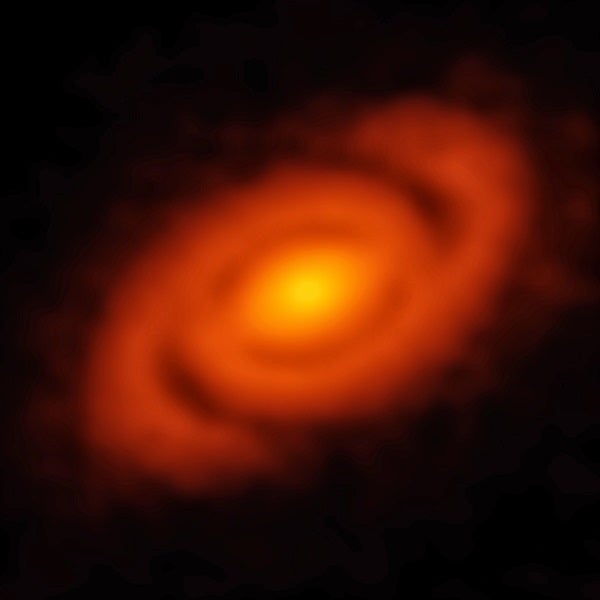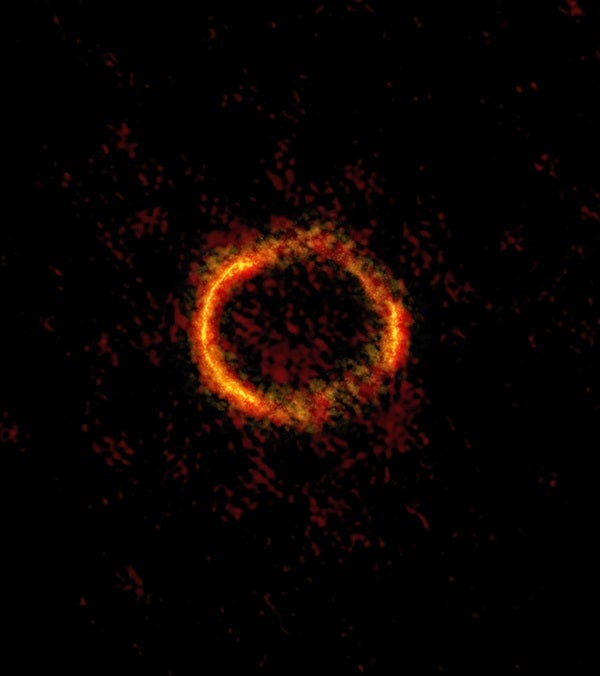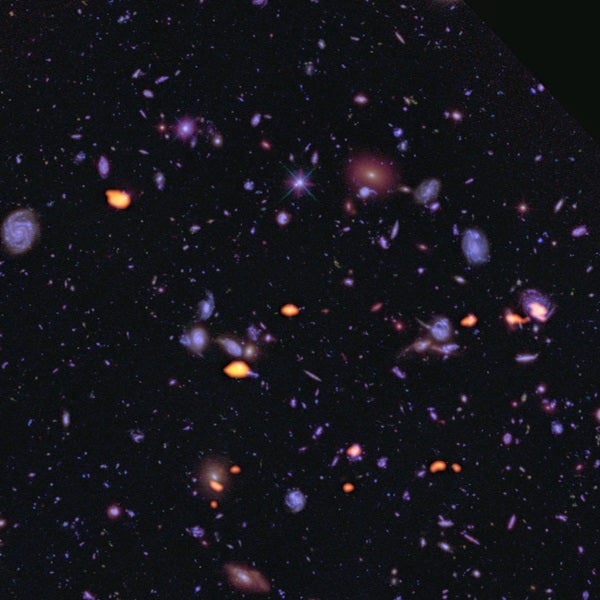ALMA is two arrays in one: Fifty 12-meter antennas form its configurable array, and 12 7-meter antennas (with 12-meter antenna corners) form its static, central compact array. ALMA is a partnership of North America, East Asia, Europe, and Chile; its name means “soul” in Spanish.
During its first five years observing the darkest secrets of the universe, the Atacama Large Millimeter/submillimeter Array (ALMA) has proven itself one of the most powerful telescopes of its kind ever built. Theories once believed impossible to confirm have been substantiated or deprecated by a quick and clear ALMA observation, with the bonus of new mysteries that will keep scientists and computer modelers busy for some time to come.
What is ALMA’s superpower? ALMA observes, with greater precision than any other telescope, a holy grail form of light that comes from dust and molecules, the little Legos that assemble all familiar structures of the universe. ALMA detects these in wavelengths that are slightly longer than infrared, but shorter than most microwaves, making ALMA the higher-frequency cousin to a radio telescope array.
Like radio waves, these millimeter- and submillimeter-length waves are abundant in the cosmos. Because only a small amount of energy from a moving molecule is needed to generate them, even cold dust at a mere 10 kelvins can shine in this type of light. Although millimeter/submillimeter waves are weak, they can escape from the most distant, densest, and darkest regions of space — and they are the tantalizing whispers from the universe’s most hidden building activities, present and past.
What revelations have the molecules ALMA observes showed us, then?
A menagerie of solar systems
Dust is the curtain that obscures the most private affairs of the universe from our stalking optical telescopes. The secret origins of stars and planets — the necessities of every solar system — can happen only in these dark hideaways. For prying millimeter and submillimeter eyes, however, those curtains are transparent.
Growing up too soonHL Tauri is a very young protostar. No more than a million years old, it has gathered bright, hot material around it, but has not yet collected enough mass to crush its core into a fusion reactor. This early stage of star formation, known as the T Tauri phase, is named for the exemplar star, a neighbor in the constellation Taurus.
Optical telescopes will never see into the HL Tauri system itself, but they have imaged a pinkish jet that can be traced like an arrow back into a bright blue reflection nebula where, deep within, HL Tauri grows. This jet has its own name, Herbig-Haro 150–151, and it thrives on strong magnetic fields to power it and a large spinning disk of material to feed it. The disk was traced by early infrared and radio observations of HL Tauri that detected molecules oriented and moving in a tilted disk shape around the Sun-like protostar.
Years of ideas about HL Tauri culminated with history’s first high-resolution look at the system with ALMA: The image was like an artist’s drawing of the planet-making phase of solar system formation, and the world gasped.
Models predict that if a star can hold on to a large enough disk of material throughout its tumultuous formation, the disk should get lumpy over time. Dust molecules should hang together by static cling or the stickiness of ice from collisions (icy coatings melt slightly upon impact, but refreeze quickly to join bits together, similar to getting your tongue stuck to a frozen metal pole).
These cosmic dust bunnies should continue to collect particles as they roll around in the orbiting disk, getting larger and larger over millions of years until they command enough gravity to pull material onto themselves. When these protoplanets have claimed sufficient material from their surroundings, models predict that their orbits should then appear as empty rings or gaps in the dusty disk — which is exactly what ALMA saw around HL Tauri.
While this historic observation is incredible, the bigger story is how a protostar as young as HL Tauri is making planets so soon! Molecules should find it too difficult to hang on to each other in the maelstrom of turbulence, radiation, and outflows surrounding this merely 1 million-year-old, jet-studded protostar. And yet, very clearly, they have. The inexplicable HL Tauri system sent astounded scientists back to their calculations, hungry for more ALMA data of other baby solar systems. They didn’t have long to wait.
Star-formation models expect growing stars to clear this area later in their development via the leaf-blower effects of their energetic winds, their collection of material into themselves, and their disk’s jets expelling charged particles up and away from the hot core. Therefore, taking ALMA’s TW Hydrae result on its own, the conclusion seems obvious: no planet. But on the heels of the HL Tauri bombshell, the TW Hydrae inner gap result is spurring sparkling debate at conferences and in astronomy journals.
A spiral surprise
At only half the mass of our Sun, the protostar Elias 2–27 has way more material orbiting it than a baby red dwarf star should. In ALMA images, the star boasts a gap in its massive disk at a distance suggesting the presence of an unseen planet. But ALMA also discovered two gorgeous spiral arms wrapped around the disk, making the system appear like a miniature spiral galaxy.
Spiral galaxies get their distinctive shape from density waves, which are the slow-moving gravitational traffic jams that concentrate gas and dust into arcs in the disk of a galaxy. Spiral density waves are the sites of the most star formation in those giant structures.
“This is the first time that we have been able to trace spiral density waves down to the region where planets may form in a protoplanetary disk,” explains Laura Pérez, Alexander von Humboldt Fellow at the Max Planck Institute for Radio Astronomy and the lead astronomer behind the Elias 2–27 discovery. Density waves could instigate the formation of planets in orbits well beyond the distances expected for stars of this modest size. Pérez says the trigger of the wave remains a mystery, but could have been instabilities in the unusually massive disk or even an unseen companion outside the system.
“We don’t yet know why solar systems evolve so differently from one another,” explains Pérez. “We have many ideas: the amount of dust and gas in each disk, their surrounding natal environment, the properties of the protostar in relation to its disk, and a big et cetera! This is why we built and need ALMA.”
The time-honored models of planet formation are based on the solar system we know best — our own. In the single generation since we’ve been spying on other mature solar systems, however, we’ve humbly learned how divergent they are from ours. Now, with ALMA’s incomparable ability to image so many brow-furrowing protosolar systems, those models are really showing their age.
Which is why Pérez is behind a huge new observing program with ALMA to hunt and catalog more young solar systems. Like a cosmic game of Pokémon Go!, she and her colleagues will collect as many examples of protoplanetary disks as possible, building a menagerie in which to study how solar systems truly form.
Galaxies have been the workhorses of the cosmos since its earliest years: They gather the mass — unseen and seen — and they make and trace the large-scale structures. Their star making and breaking creates the radiation and molecules needed to keep the cycle going. Astronomers would really like to know how galaxies formed, and not only because we happen to live in one.
So, we look back. Way back. As far back as we can, and ALMA’s antennas were built to be very sensitive, perfectly shaped, and plentiful, to detect the weary waves that have traveled to us from the early universe. Its 50 12-meter antennas are regularly uprooted and relocated to new anchors across the ancient volcanic plain, changing the resolution of ALMA’s vision, while a supercomputer accounts for it all. Without this brain, ALMA is just a sophisticated Star Wars filming location.
At petaflop speeds (roughly 17 quadrillion operations per second), ALMA’s supercomputer (known as a correlator) mathematically stacks each antenna’s live data with the others, in pairs, until all pairs are merged and the results combined. The farther apart the antennas are placed, the better the noise cancels out, and the higher real signals rise. The resulting interference pattern of combined data creates images and spectra sharper than any other telescope of its type — up to 10 times the resolution of the Hubble Space Telescope (HST) — that give ALMA its dominance in millimeter/submillimeter astronomy.
A ring to rule them all
Astronomers tested ALMA’s resolving power by hauling its antennas out to the array’s limits, with some antennas working 9 miles (15 km) from each other. They then aimed the array at the gravitationally lensed galaxy known as SDP.81, which, thanks to the magnification of space around a massive foreground galaxy, peeks out from 2.2 billion years after the Big Bang.
In this long baseline configuration, ALMA achieved 0.023″ resolution, mapping dust, carbon monoxide, and water structures in this lensed galaxy on the scale of only a few hundred light-years, the size of individual molecular clouds. Lensing creates a ring effect because of the shape of the object coming between the light of the distant object and the observer. ALMA imaged details in this ancient galaxy so clearly, in fact, that computer modelers were able to de-warp the ring and reassemble SDP.81’s true appearance as a young galaxy making its first stars over 11 billion years ago!
From ALMA’s high-resolution spectral data, astronomers clocked the spin of this young galaxy and learned its mass. They even spotted some molecular clouds on the eve of collapse into stars. Leagues ahead of other instruments, ALMA will continue to use these fortuitous cosmic magnifying glasses to gather the most detailed and critical clues about how galaxies like our own Milky Way Galaxy formed so many billions of years ago.
ALMA is not tuned to see starlight; remember, its prowess is in its ability to detect molecules. Starless protogalaxies are invisible to Hubble during their earliest phase of gathering material, but their molecules give them away. Molecules are the waste products of stars — supernovae make them, so their presence is a tracer of star formation, even when the star formation is hidden inside cold clouds of dust and stuffed deeply into the bellies of dark mountains of gas that will ultimately become the first galaxies.
After 40 hours of staring at nothing, ALMA struck gold (or rather, carbon monoxide molecules, which are the preferred currency in the galaxy-formation community). Enormous reservoirs of carbon monoxide dominate the distant, ancient universe, providing tenfold more star-forming fuel than at any other time in our universe’s history. Quite an aha moment for scientists, who have long wondered why we don’t see massive galaxies forming in our time as they did so readily in the past.
As a result of this breakthrough, teams of astronomers from around the world have been granted hundreds more hours to look deeply into the past for more scenes from this Golden Age of Galaxies.
The soul of ALMA
Although we are awed by ALMA’s tremendous results to date, insiders say that we ain’t seen nothin’ yet.
“ALMA is now in Cycle 4, and the era of Large Projects has begun,” Impellizzeri explains. “We’ve gotten through the very competitive and necessarily risk-averse early years, but now many scientists have been awarded longer observing hours with numerous targets to explore, including deep searches primed for serendipitous discoveries. We are about to truly harness the power of ALMA.”
As the Large Projects deliver terabytes of the highest-resolution and highest-sensitivity data ever taken of the cold, dark origins of everything in the universe, and as scientists dig for treasure in the monstrous, growing online archive of ALMA observations, countless more history-making results will stack until the signal of ALMA’s manifold impacts on our understanding of our universe rises clearly.
As game-changing as they will be for the field of astronomy, these advances pale against the triumphs of the international community that is ALMA. Cultural differences, time zones, natural disasters, and shifting government priorities — even currency fluctuations — influence the project relentlessly because of all the nations and organizations involved. And yet, it succeeds, wildly.
What is so special about an array of antennas that allows it to unite so many distinct individuals?
ALMA is the most powerful ally humankind has ever had on our intensely spiritual quest to explore and understand our cosmic origins and progress humanity’s abilities in service to that mission.

